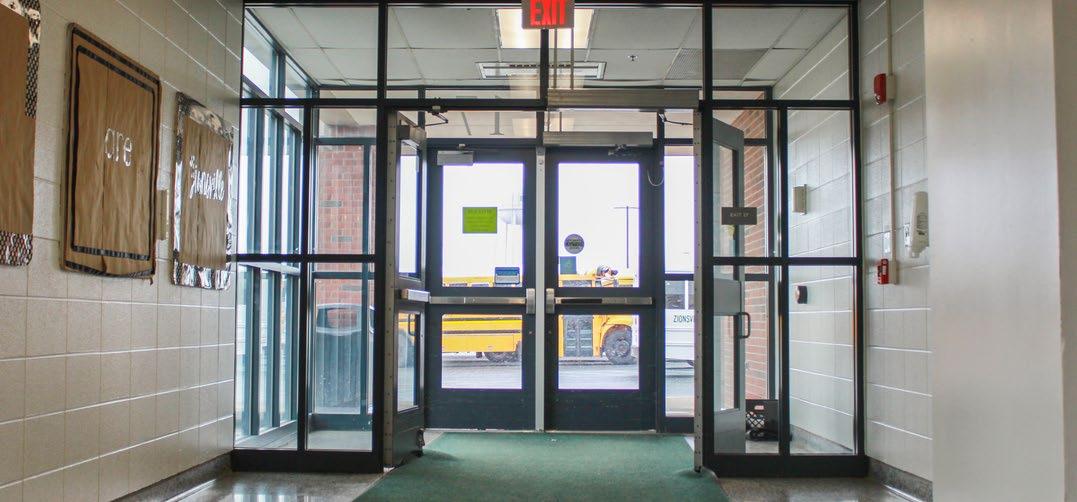
3 minute read
School Securein the
School safety top of mind for school officials, police
By Brooklyn Brown, Arts and Graphics and Mary DeMarco, Editor in Chief
Advertisement
Picture this: it’s one of those days when getting out of bed feels impossible. You’re late to school and hope to quickly sneak in through the wedge doors. You waste time going from one locked door to another. Do you call a friend to let you in or admit defeat and make the walk of shame to door one and accept your tardy?
Although students may have been able to enter and exit through many different doors in previous years, this year, ZCHS administrators have enacted stricter door policies.
This change might be to the dismay of students running late or trying to sneak out for lunch, but the decision was made for the good and safety of everyone in the building, according to Jared Williams, assistant principal and state-certified school safety specialist.
“I know kids get irritated with me sometimes if I’m addressing [opened doors],” Williams said. “It really has nothing to do with me not wanting you to get DoorDash here or me not wanting you to have a shorter walk, it really does come down to the safety and security of the building.”
Ever since the shooting at Columbine almost 25 years ago, the safety of both students and staff has been on administrators’ minds. Students are familiar with the names of different schools affected by active shooter events; Sandy Hook, Parkland, Ulvade, and, most recently, Michigan State.
The reality is that the possibility of a school shooting is ever-present, and that’s why the administration is constantly working to improve safety protocols. Keeping doors locked is just one small part of this.
“We work in two different avenues: response and prevention,” Chad Smith, Zionsville’s district school safety specialist, said.
According to Principal Tim East prevention starts with “being attentive” to the student body and their mental and physical health needs. East said counselors and school social workers are hired to “provide immediate support” for students who “may be having some mental or emotional struggles.”
Alongside this, Smith said other preventative layers are put in place to protect the school, such as the tip line where anyone who sees or knows something can report it.
“The part they don’t know is that we take every one of those [reports] and we do something,” Smith said.
Administrators have planned out a course of action in case what East describes as the “unthinkable” occurs. Students are very familiar with the ALICE drills. According to alicetraining.com, the official ALICE drill information site, the acronym is best defined as: alert, lockdown, inform, counter, evacuate.
Zionsville students and students across the country have been practicing ALICE training since elementary school. What students don’t witness is the intensive behind-the-scenes training of school resource officers (SRO). Lieutenant Adrian Martin is currently the ZCHS SRO.
“[SROs] really are trained different as police responders and police officers than your average policemen,” Martin said. ”The men and women that do the job at the SRO are actually trained at a higher level because they are at a community-based policing and that’s really complicated.”
Sometimes training goes as far as hiring actual actors to role-play an active-shooting scene and give officers real-time experience.
Smith said Indiana is an “exemplar” as far as school safety training. He said that now the schools that he oversees are prepared to respond immediately, in contrast to Columbine where there was not a quick response.
By continuing conversation about events like this, East said preventative measures can be “applied in a way to prevent it from happening on another campus.”
“As close to home as it ever got was Noblesville,” East said. “There are students who were in the school when that occurred in the middle school. They graduate this year,” East said.
Students can best help by checking in on their peers. East said students should reach out to trusted adults and counselors if anyone they know is struggling with thoughts that could mean harm to themselves or others. This line of communication “allows all of that training that’s happening behind the scenes to assess that threat and determine what supports are necessary,” East said.
Finally, Smith urges students to simply not let others into the building.
“I always look at the school as our home,” Smith said. “We want to know who is in our school, just like our home. We want our doors to be locked, just like it is in our home.”










